There’s a lot more to thoroughly enjoying and appreciating weed than just smoking it. For starters, knowing how to store it properly to keep it at peak freshness before you partake is an important factor that often goes overlooked. Understanding how to preserve the quality and potency of your stash is essential for the best possible flavours and effects.
It’s all about the quality and experience. When weed isn’t stored correctly, cannabinoids and terpenes—the compounds responsible for its potency and flavour—can break down over time. While it doesn’t “go bad” in the traditional sense, improperly stored weed won’t deliver the same potency or taste, leaving you with a less satisfying experience.
Below, we’re breaking down the art and science of storing weed effectively. We’ll explore how factors like temperature, humidity, light, and air can impact your precious buds and what steps you can take to ensure they remain in prime condition. By the time you finish reading, you’ll be equipped with weed storage tips, knowledge, and tools to keep your cannabis in excellent condition, ensuring each smoke sesh is as enjoyable as the last.
What Affects the Shelf Life of Weed?
Before we jump into the nitty-gritty of proper weed storage methods, it’s crucial to understand what factors affect the shelf life of your weed. Cannabis doesn’t spoil like food most of the time, though just like any other plant, it might rot or get mouldy if it isn’t appropriately dried or stored correctly. The bigger issue regarding the shelf life of your weed is the factors you expose it to. Exposure to extreme temperatures, improper humidity levels, light, and oxygen can all take a toll on your stash, causing it to go through changes over time that make it feel less potent or flavourful.
When cannabinoids and terpenes—the compounds responsible for the unique effects and flavours of different strains—break down due to adverse storage conditions, your weed can lose its magic. The entourage effect, which results from the synergy between various cannabis compounds, including cannabinoids and terpenes, diminishes when these essential constituents are compromised.
Exposure to environmental fluctuations can cause cannabinoids to break down and terpenes to evaporate away. What that means is restricted potency because there are fewer compounds to support the entourage effect. It also means that your bud is going to stop smelling like a flower, and the hay-like flavour and aroma are telltale signs that something isn’t right.
We wrote a much more in-depth article about how exposure to extreme temperatures, improper humidity levels, light, and oxygen break down your buds on a scientific level, so be sure to check that out. But at the end of the day, improperly stored cannabis may leave you with a lacklustre and unsatisfying experience, far from what you’d expect from a fresh and well-preserved stash.
5 Tips for Storing Your Weed
Now that we’re up to speed on the whys, let’s jump into the hows. Below, we’re breaking down five key aspects of effective weed storage to help you maintain potency, flavour, and freshness. Let’s dive in:
1. Use proper weed storage containers
The choice of storage container plays a pivotal role in preserving the quality of your cannabis. Sure, it’s easy to toss weed into a plastic baggie and forget about it. But the problem is that those plastic bags aren’t airtight and can contribute to the speed at which your buds break down. When weed is exposed to air, oxygen can cause the breakdown of cannabinoids, leading to a loss of potency over time. Exposure to oxygen also contributes to drying out your weed, evaporating the cannabinoids out with it. To combat these issues, it’s essential to use airtight containers that keep air out and maintain a stable environment for your weed.
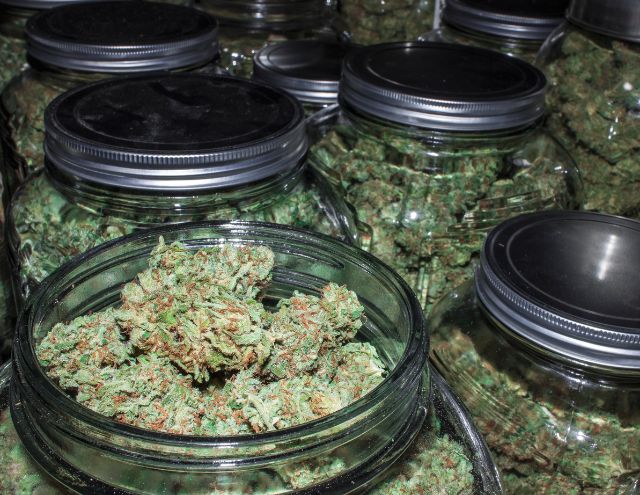
However, it’s essential to remember that solving one problem will only cover some of your bases. An airtight container is a great place to start since it also has the added benefit of optimising humidity levels and can be designed to keep light out. Here are some options to consider:
- Airtight, Light-Resistant Containers: These containers are designed to keep air and light out but moisture in, which all help to prevent the degradation of cannabinoids and terpenes. As far as suitable storage containers go, plastic, ceramic, or glass jars designed to keep air and light out are some of the best and most accessible options for weed storage. They come in various sizes and are typically made from opaque materials to keep light out, which can also degrade your weed.
- Mason Jars: Mason jars are a popular choice for their airtight seal, which keeps the air out and the moisture in. Since they’re made from a good, sturdy glass material and easy to get ahold of without breaking the bank, they’re a great runner-up option. They also come in various sizes. The only downside is that since they’re not lightproof, they must be stored in the dark for best results.
- Vacuum Sealers: Lightproof, airtight containers are perfect for accessing a stash regularly, but you can’t beat a vacuum sealer for long-term storage. Vacuum sealers remove the air from the container, creating a vacuum that prevents oxidation and degradation. However, while it’s a good option for long-term storage that keeps air out and keeps the trichomes on the bud, the process of vacuum sealing will compress your buds and also suck out some of the humidity, which takes terpenes with it. It’s helpful in a pinch where you have a surplus you need to store for over a year, but it’s not recommended for short-term storage.
2. Store in optimal temperatures
Temperature control is critical to preserving your weed’s quality and potency. Extremes in temperature, whether too high or too low, can adversely affect your stash. For starters, storing your cannabis in a hot environment can accelerate the breakdown of cannabinoids, leading to a decrease in potency. It can also cause your weed to become dry and brittle, making it harsh to smoke and less enjoyable.
On the other hand, frigid temperatures, such as refrigerated or freezing, can cause the trichomes (the resin glands containing cannabinoids and terpenes) to become brittle and break off, further diminishing the potency and flavour of your weed. Your cannabinoids and terps are found in those precious trichomes, so they must be protected at all costs.
All that is to say that if you want to make sure your buds stay fresh, aim to store them in your airtight container at room temperature, which typically falls between 15-20°C (60-68°F). This temperature range provides a stable environment that minimises the degradation of cannabinoids and terpenes, helping your weed retain its potency and flavour.
Luckily, there are many places around your home to store your weed containers. Even if you prefer to keep your home warmer in the winter, a dark closet, a dresser drawer, or a kitchen cupboard usually stays cooler. As a bonus, they’re also areas of the home that are free from light, which is excellent if you choose an airtight container that isn’t lightproof on its own. You can also choose a dedicated stash box or any place where you can maintain a consistent and moderate temperature.
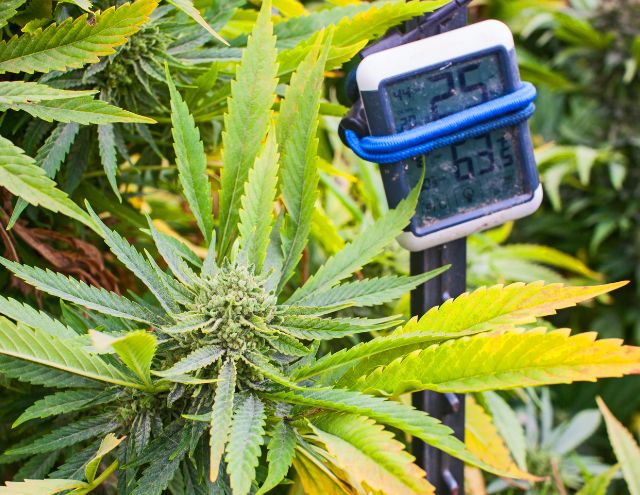
3. Maintain optimal humidity levels
Too much or too little humidity can lead to several issues that affect both the taste and potency of your weed. When cannabis becomes excessively dry, terpenes can evaporate, resulting in a less aromatic and flavourful experience. Additionally, overly dry weed can crumble into dust, making it challenging to handle and smoke. But on the other hand, excessive humidity can lead to mould growth, which poses health risks when consumed. Mouldy cannabis typically has a musty, unpleasant, hay-like odour and is unfit for consumption.
Proper humidity is crucial because it helps preserve the moisture content in your cannabis, preventing it from becoming too dry or too moist. For cannabis, it’s best to store your buds in a container kept at 55-62% Relative Humidity (RH.) Keeping your buds in that sweet spot of perfect humidity keeps them smelling at their best and reduces your risk of mould or rot.
We recommend using a hygrometer within your airtight container to monitor your humidity levels. A hygrometer measures the humidity levels in your storage container and allows you to monitor and adjust humidity as necessary by adding humidity or opening the jar to allow some moisture to escape. To use one, drop the device into your container and view it from the outside, or use a model with a probe or bluetooth connectivity that allows you to read the display without opening the jar.
However, if you want to remove some of the stress, use a 2-way humidity pack designed explicitly for weed. These packs release or absorb moisture as needed to keep the relative humidity within the ideal range of around 55-62%.
Other methods, such as placing a piece of bread, citrus peels, or humidity stones in your storage container can also help regulate humidity— but they have pros and cons. For example, bread and citrus peels will impart unwanted flavour into your buds and can often make the humidity too high. Humidity stones can dry out but may add too much moisture at first. That said, if you use an alternative to a 2-way humidity pack, use a hygrometer with it and keep an eye on your container so you don’t ruin your stash.
4. Avoid light exposure
As we touched on briefly in the container section, light degradation is another factor that can significantly impact the quality of your cannabis. Exposure to light, especially UV (ultraviolet) light, can lead to the breakdown of cannabinoids and terpenes, which are responsible for your weed’s potency, flavour, and aroma.
UV exposure is a huge threat to THC specifically and can contribute to how fast it breaks down. Light also helps accelerate how quickly your terpenes evaporate, leading to flavourless buds that don’t feel as potent.
It’s best to store your weed in the dark in an airtight container away from high temperatures with a 2-way humidity pack. Keeping your cannabis in the dark also helps prevent mould growth. Mould thrives in warm, damp conditions, and the combination of humidity and light can create the perfect environment for mould to develop. Keeping your weed in a dark space reduces this risk.
Opt for storage containers that are opaque or UV-resistant. These containers shield your cannabis from harmful UV rays while keeping it in the dark. You’ll also want to choose dark and discreet locations if you’re using an airtight container that isn’t opaque, like a mason jar. A dark closet, a drawer, a stash box, or any place away from direct sunlight or artificial light sources is ideal.
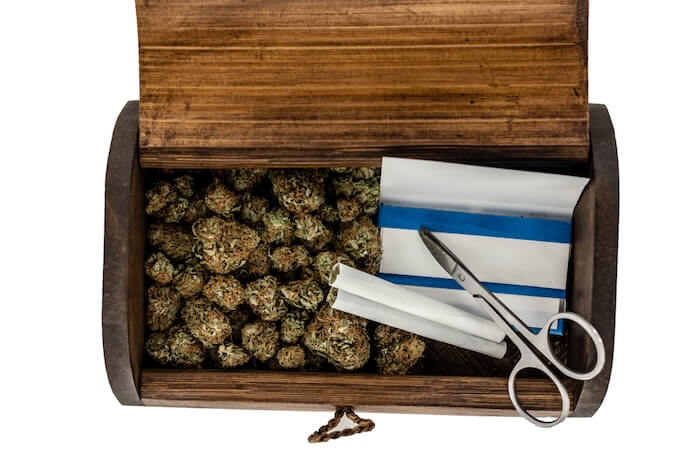
5. Avoid touching your buds
Handling your cannabis with care is the final piece of the puzzle when it comes to effective weed storage. While it may seem like a minor detail that often gets overlooked, how you handle your buds can greatly impact their overall quality, potency, and flavour.
For starters, when you handle your buds with your fingers, you’re more likely to break trichomes off of the flowers. Since your trichomes contain cannabinoids and terpenes, you want to work hard to keep them on the bud. The more you damage them, the less potent your buds will feel. That said, you want to keep handling to a minimum and try not to disturb your buds too much in storage. Shaking your weed jar might be good for fluffing them up and preventing mould, but aside from that, try not to physically handle or aggressively jostle your buds whenever possible.
To take it a step further, the natural oils on your skin can transfer onto the cannabis. These oils may contain contaminants or microbes that can affect the flavour and potentially compromise the safety of your weed. The oils on your skin can also break down those trichomes, even if they’re not being forcefully separated through touch alone.
That said, when you’re handling your cannabis, especially if you’re preparing it for consumption, use latex or nitrile gloves or a pair of tongs. These tools minimise direct contact and prevent the transfer of oils and contaminants. By taking these precautions, you’ll help ensure that your cannabis remains as potent, flavourful, and safe as possible. Every small step you take in preserving the quality of your weed contributes to a more enjoyable and satisfying experience when it’s time to indulge.
Tips for Storing Different Marijuana Products
While buds may be the most finicky version of cannabis to store, there are a lot of other cannabis products out there you’ll want to take extra care to store correctly if you want to preserve their integrity, potency, and flavour. Here are the best practices for storing weed products by type:
How to store cannabis flowers
You’re an expert in this department after reading everything above. But here’s the gist:
- Use airtight containers or mason jars to keep your buds fresh.
- Ensure that the container is clean and dry before placing the buds inside.
- Store in a dark place away from direct sunlight or artificial light sources.
- Aim to store your weed between 15-20°C (60-68°F).
- Maintain the ideal humidity level of around 55-62% to prevent your buds from becoming too dry or too moist. Humidity packs or hygrometers can help you achieve this balance.
How to store cannabis edibles
Unlike flowers, edibles–just like food– can spoil and go bad. They’re affected most by humidity, heat, contamination, and sun exposure. Most edibles, like chocolates or gummies, are shelf-stable for up to a year at room temperature. However, edibles you make from home with perishable ingredients should be kept in the refrigerator for up to a week. Remember to follow the manufacturer’s freshness instructions on the label and trust your senses. If it looks like it’s spoiled, or if there’s anything off about it, just throw it out. Since edibles also contain cannabinoids, you’ll want to preserve them by keeping them away from air, light, high humidity, and extreme temperatures.
- Store store-bought edibles in their original sealed packaging if possible. Once opened, transfer them to a lightproof, airtight container.
- Store shelf-stable edibles (anything you bought at room temperature) in an airtight container in a cool, dry, and dark place away from high humidity or extreme temperatures.
- Store cold edibles in the refrigerator for up to a week in an airtight, lightproof container.
- You can store edibles in the freezer long-term with a vacuum sealer.

How to store cannabis concentrates
Concentrates, like buds, need to be stored carefully to preserve their freshness. They’re sensitive to temperature, light, air, and moisture. Further, thanks to their unique consistencies, your container makes all the difference. It helps to follow the instructions provided by the manufacturer, but if you’ve made your own, here’s what you need to know:
- Use silicone containers to ensure sticky concentrates like wax or shatter won’t stick to materials like glass. These are ideal only for short-term storage since they’re not airtight.
- For thick concentrates that don’t run like shatter or homemade rosin, use parchment paper and place the parchment paper in a lightproof, airtight container. Store it away from light, high temperatures, and improper humidity levels.
- Use a glass container with an airtight lid for runny concentrates that aren’t sticky, like live resins or hash oils. Store it at room temperature, away from light, extreme temperatures, and improper humidity.
- Keep concentrates away from high temperatures, as they can become runny or lose their consistency when exposed to heat.
- You can freeze concentrates for long-term storage in sealed containers as long as you get all of the air out with a vacuum sealer.
- Don’t store concentrates in the refrigerator since they can dry out your concentrates and create moisture on the lid, which will affect your dabs.
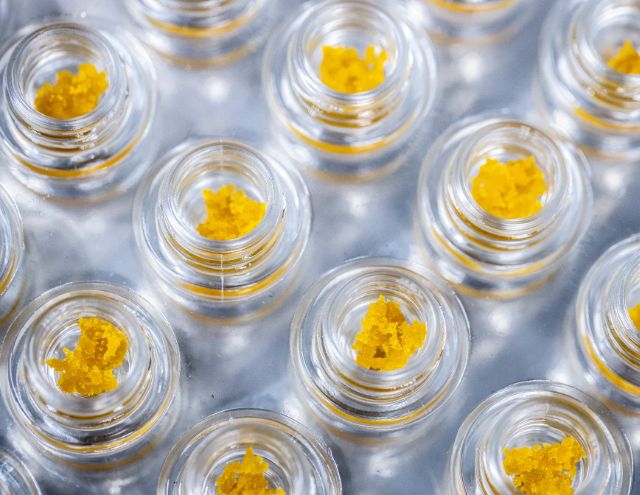
How to store cannabis tinctures and oils
Tinctures and cannabis oils are normally sold in opaque glass containers, which are designed to prevent contamination and light exposure. It helps to keep them in their original containers and follow the manufacturer’s instructions for storage.
- Store tinctures and oils in a lightproof, airtight container. It helps to keep them in their original packaging or a small opaque glass bottle.
- Store them in a cool, dry, and dark place to maintain their effectiveness.
- Only store them in the refrigerator if instructed to do so. Room temperature is ideal for cannabinoids.
- Avoid putting the dropper directly into your mouth to prevent contamination of the batch.
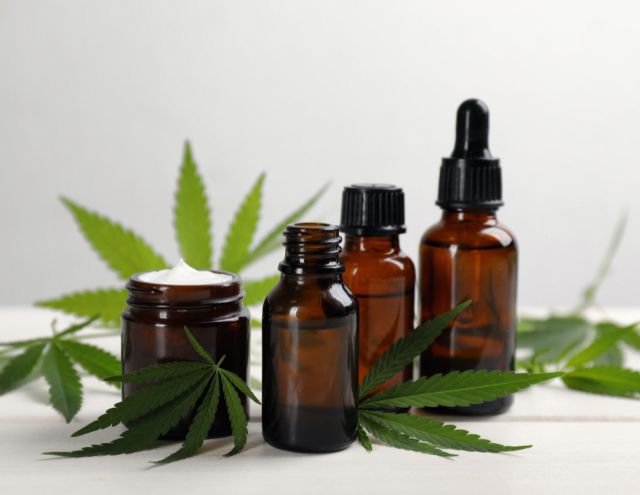
How to store topical cannabis products
Like tinctures and some edibles, topicals are usually shelf-stable and come in the perfect packaging for cannabinoid preservation. Always follow the manufacturer’s instructions for storage and keep them in a cool, dry place in an opaque container. Avoid exposing them to extreme temperatures, affecting their consistency and effectiveness.
How to store pre-rolled marijuana joints
Pre-rolls follow all of the same rules as buds. For best results, invest in an airtight joint tube to preserve its freshness and aroma when you take a single joint on the go. On the other hand, if you find yourself rolling joints for the month all at once, store them the same way you would store buds: in an airtight container away from high temperatures in a cool, dry, and dark place. If necessary, use humidity packs to maintain the right moisture level and prevent joints from becoming too dry.
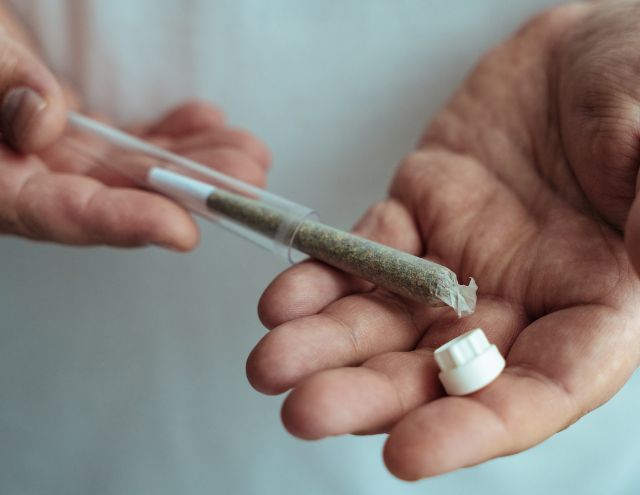
Common Mistakes to Avoid in Marijuana Storage
Proper marijuana storage is essential for preserving the quality and potency of your cannabis products. To emphasize the importance of effective storage, it’s equally crucial to highlight common mistakes that can compromise your stash. Here are the key blunders to avoid:
- Using inappropriate containers like plastic bags or clear containers that aren’t airtight.
- Not sealing containers properly, allowing air to degrade your cannabis.
- Neglecting humidity control, leading to overly dry or overly moist cannabis, soggy concentrates, or mouldy edibles.
- Exposing any of your cannabis products to light, especially UV light, which degrades cannabinoids and terpenes.
- Storing cannabis products in the fridge (unless directed to by the manufacturer in the case of edibles,) causing potential issues like condensation, mould, or broken trichomes which affect potency.
- Not vacuum sealing your cannabis concentrates, edibles, or buds to remove air before long-term storage with a freezer.
- Using plastic bags for long-term storage, which offers inadequate protection from all of the elements that break down cannabinoids and terpenes.
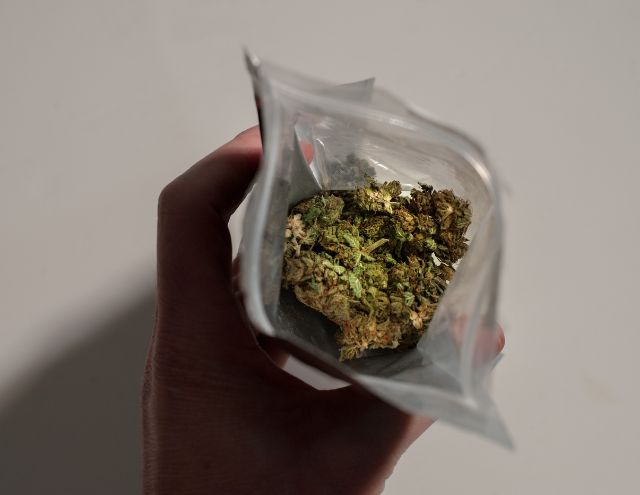
Conclusion
At the end of the day, storing weed properly is essential. Proper marijuana storage safeguards the potency, flavour, and overall quality of your cannabis products. Factors like temperature, humidity, light, and air can affect your cannabis, leading to changes in taste and potency. Luckily, your choice of storage containers, temperature control, humidity maintenance, avoiding light exposure, and careful handling all play pivotal roles in how long your weed lasts.
But like most things, storage is variable. Even if you do everything right, sometimes a contaminant or a rapid fluctuation can ruin your whole stash, regardless of what kind of product it is. With that in mind, remember to trust your gut. While weed usually doesn’t go bad in the sense that it’ll make you sick, it can be unpleasant to smoke, and you always want to be on the lookout for mould. When in doubt, just throw it out. Getting weed is easier now more than ever, and life is way too short to smoke bad weed.
When you take the time to store your cannabis correctly, you not only preserve its quality but also ensure a safer and more enjoyable experience. Remember, cannabis is an investment, and treating it with care will always yield the best results. By following the guidance provided in this article, you’re well-equipped to enjoy every smoke session to the fullest.
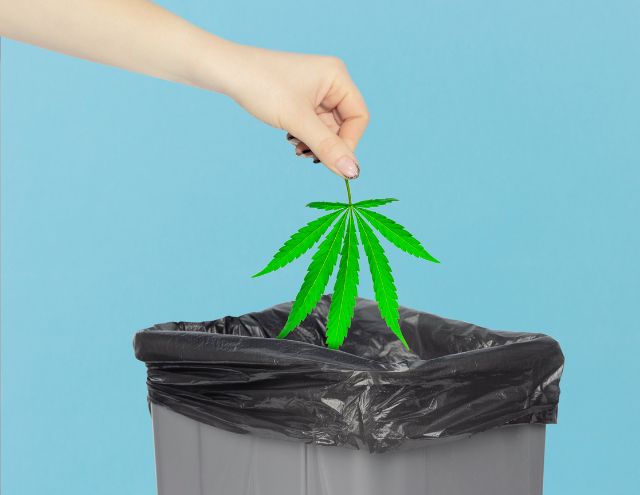
FAQs
Q: How long can I store marijuana?
A: In general, if stored correctly, cannabis flowers can remain potent and flavourful for up to 12-18 months, while other products like concentrates and edibles may have longer shelf lives. Always follow the manufacturer’s instructions for storage tips, and remember— if it doesn’t look, smell, or taste right, get rid of it.
Q: Can I revive expired marijuana?
A: Unfortunately, once marijuana has degraded significantly, it cannot be fully revived. Proper storage can slow the degradation process, but it’s essential to consume your cannabis within a reasonable timeframe for the best experience. There are some things you can do if your weed isn’t fully ruined, though. Like rehydrating it or reintroducing terpenes, for example.
Q: How to rehydrate old weed?
A: To rehydrate overly dry cannabis, place it in an airtight container with a humidity pack for a few hours to restore moisture gradually. You can also use alternative methods, like adding a slice of bread, an orange peel, a humidity stone, or the risky hot vapour method. Be cautious not to overhydrate, as this can lead to mould growth.
Q: Is it safe to freeze marijuana?
A: Technically, yes, it’s safe to freeze weed as long as you get all of the air out before storing it long-term. Freezing cannabis is generally not recommended as it can lead to trichome breakage and moisture-related issues when thawing. Stick to room temperature storage for optimal results.
Q: What is the best way to store weed?
A: The best way to store weed involves using airtight, UV-resistant containers, maintaining proper humidity levels (around 55-62%), storing in a cool, dark place, and avoiding direct handling to prevent oil transfer.
Q: What is the shelf life for cannabis products?
A: Shelf life varies by product. Cannabis flowers typically last 6-12 months, while concentrates and edibles can remain potent for longer periods. Always check product labels for expiration dates when available.
Q: How to know when to throw away old weed products?
A: Trust your senses. If your cannabis has an unusual appearance, an off-putting smell, or a compromised flavour, it’s a sign that it may have degraded. When in doubt, it’s better to discard it and replace it with fresh products for a safer and more enjoyable experience.






Leave a Reply